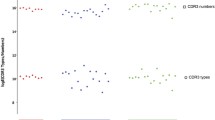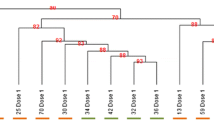Abstract
The T cell receptor (TCR) αβ variable(V) gene family usage of tumour-infiltrating lymphocytes (TIL) in four different primary human malignant melanomas and their corresponding metastatic lesions was characterized using a recently developed method based on the reversetranscription-coupled polymerase chain reaction (RT-PCR). All patients were typed for HLA-A1 and-A2, either serologically or by a newly developed RT-PCR method. Two of these patients expressed HLA-A2, one the HLA-A1 haplotype and one further patient was heterozygous HLA-A1/-A2. The prognostic parameters for all four patients indicated that rapid progression of the disease was to be expected. However, only two of the patients showed rapid progression, while the remaining two patients are still alive after more than 3 years. In TIL in primary melanomas, a possible correlation was suggested between HLA-A2 and the preferential usage of the TCR V gene families Vα4, Vα5, Vα22 and Vβ8, whereas the Vβ3 gene family appeared to be expressed together with HLA-A1. Other highly expressed V gene families, apparently not restricted to either HLA-A1 or-A2, were Vα1 (expressed in three of four primary tumours) and Vα21 (expressed in two of four tumours). We found no evidence suggesting any correlations between the haplotypes HLA-A1 and-A2 and preferential V gene family expression in the metastatic lesions, and the only common feature was Vα8, which was found to be highly expressed in two out of three subcutaneous metastases. The V gene families, which were highly expressed in the primary tumour were generally not, or only very weakly, expressed in metastases and vice versa, possibly reflecting a change in the phenotype of the metastatic melanoma target cells. With regards to patient 0368, it was possible to obtain and study material from two subcutaneous metastases. The first metastasis was excised more than a year after the primary tumour, showing a completely different V region repertoire. The second metastasis was excised at surgery 2 years after primary surgery and likewise showed a dramatic shift in comparison to the first subcutaneous metastasis. Although the present study only included a small number of patients, it suggests that the estimation of V gene expression, if applied to a larger amount of patient material, might make it possible to substantiate further the suggested correlations between the T cell response against the tumour, HLA and antigen expression. Such studies will be of obvious interest in the further analysis of new immunotherapeutic regimens involving the T cell response against tumours.
Similar content being viewed by others
References
Anichini A, Fossati G, Parmiani G (1985) Clonal analysis of cytotoxic T-lymphocyte responses to autologous metastaticmelanoma. Int J Cancer 35: 683
Bakker ABH, Schreurs WJ, Boer AJ de, Kawakami Y, Rosenberg SA, Adema GJ, Figdor CG (1994) Melanocyte lineage-specific antigen gp100 is recognized by melanoma-derived tumour-infiltrating lymphocytes. J Exp Med 179: 1005
Becker JC, Schwinn A, Dummer R, Burg G, Bröcker E-B (1993) Lesion-specific activation of cloned human tumour-infiltrating lymphocytes by autologous tumour cells: Induction of proliferation and cytokine production. J Invest Dermatol 101: 15
Becker JC, Brabletz T, Czerny C, Termeer C, Bröcker E-B (1993) Tumor escape mechanisms from immunosurveillance: Induction of unresponsiveness in a specific MHC-restricted CD4+ human T cell clone by the autologous MHC class II+ melanoma. Int Immunol 5: 1501
Boitel B, Ermonval M, Panina-Bordignon P, Mariuzza RA, Lanzavecchia A, Acuto O (1992) Preferential Vβ gene usage and lack of junctional sequence conservation among human T cell receptors specific for a tetanus toxin-derived peptide: Evidence for a dominant role of a germline encoded V region in antigen/major histocompatibility complex recognition. J Exp Med 175: 765
Brichard V, Van Pel A, Wölfel T, Wölfel C, De Plaen E, Lethé B, Coulie P, Boon T (1993) The tyrosinase gene codes for an antigen recognized by autologous cytolytic T lymphocytes on HLA-A2 melanomas. J Exp Med 178: 489
Browning MJ, Krausa P, Rowan A, Bicknell DC, Bodmer JG, Bodmer WF, (1993) Tissue typing theHLA-A locus from genomic DNA by sequence specific PCR: Comparison ofHLA genotype and surface expression on colorectal tumour lines. Proc Natl Acad Sci USA 90: 2842
Burnet FM (1970) The concept of immunological surveillance. Prog Exp Tumor Res 13: 1
Chen L, Linsley PS, Hellström KE (1993) Costimulation of T cells for tumour immunity. Immunol Today 14: 483
Chen PF, Platsoucas D (1992) Development of the non-palindromic adaptor polymerase chain reaction (NPA-PCR) for the amplification of alpha- and beta T-cell receptor cDNAs. Scand J Immunol 35: 539
Chien Y-H, Davis MM (1993) How αβ T-cell receptors “see” peptide/MHC complexes. Immunol Today 14: 597
Chomczynski P, Sacchi N (1987) Single step method of RNA isolation by acid guanidium thiocyanate-phenol-chloroform extraction. Anal Biochem 162: 156
Clark WH (1991) Tumour progression and the nature of cancer. Br J Cancer 64: 631
Ercolani L, Florence B, Denaro M, Alexander M (1988) Isolation and complete sequence of a functional human glyceraldehyde-3-phosphate dehydrogenase gene. J Biol Chem 263: 15335
Ferradini L, Roman-Roman S, Azocar J, Michalaki H, Triebel F, Hercend T (1991) Studies on the human T cell receptor α/β variable region genes. II. Identification of four additional Vβ subfamilies. Eur J Immunol 21: 935
Ferradini L, Mackensen A, Genevée C, Bosq J, Duvillard P, Avril M-F, Hercend T (1993) Analysis of T cell receptor variability in tumour-infiltrating lymphocytes from a human regressive melanoma. J Clin Invest 91: 1183
Hall BL, Finn OJ (1992) PCR-based analysis of the T cell receptor Vβ multigene family: Experimental parameters affecting its validity. Biotechniques 13: 248
Freimark B, Pickerend L, Conconnan P, Fox R (1989) Nucleotide sequence of a uniquely expressed human T cell receptor β-chain, variable region gene (Vβ) in Sjögrens' syndrome. Nucleic Acids Res 17: 455
Garrido F, Cabrera T, Concha A, Glew S, Ruiz-Cabello F, Stern PL (1993) Natural history of HLA expression during tumour development. Immunol Today 14: 491
Gaugler B, Van den Eynde B, Bruggen P van der, Romero P, Gaforio JJ, De Plaen E, Lethé B, Brasseur F, Boon T (1994) Human gene MAGE-3 codes for an antigen recognized on a melanoma by autologous cytolytic T-lymphocytes. J Exp Med 179: 921
Genevée C, Diu A, Nierat J, Caignard A, Dietrich P-Y, Ferradini L, Roman-Roman S, Triebel F, Hercend T (1992) An experimentally validated panel of subfamily-specific oligoaucleotide primers (Vα1-w29/Vβ1-w24) for the study of human T cell receptor V gene segment usage by polymerase chain reaction. Eur J Immunol 22: 1261
Germain RN, Margulies DH (1993) The biochemistry and cell biology of antigen processing and presentation. Annu Rev Immunol 11: 403
Hérin M, Lemoine C, Weynants P, Vessiere F, Van Pel A, Knuth A, Devos R, Boon T (1987) Production of stable cytolytic T-cell clones directed against autologous human melanoma. Int J Cancer 39: 390
Itoh K, Platsoucas CD, Balch CM (1988) Autologous tumourspecific cytotoxic T lymphocytes in the infiltrate of human metastatic melanomas: activation by interleukin-2 and autologous tumour cells, and involvement of the T cell receptor. J Exp Med 168: 1419
Kawakami Y, Eliyahu S, Delgado CH, Robbins PF, Rivoltini L, Topalian LS, Miki T, Rosenberg SA (1994) Cloning of the gene coding for a shared human melanoma antigen recognized by autologous T-cells infiltrating into tumour. Proc Natl Acad Sci USA 91: 3515
Knuth A, Wölfel T, Klehmann E, Boon T, Meyer zum Büschenfelde KH (1989) Cytolytic T-cell clones against an autologous human melanoma: specificity study and definition of three antigens by immunoselection. Proc Natl Acad Sci USA 86: 2804
Mackensen A, Ferradini L, Carcelain G, Triebel F, Faure F, Viel S, Hercend T (1993). Evidence for in situ amplification of cytotoxic T lymphocytes with antitumour activity in a human regressive melanoma. Cancer Res 53: 3569
Mackensen A, Carcelain C, Viel S, Raynal M-C, Michalaki H, Triebel F, Bosq J, Hercend T (1994) Direct evidence to support the immunosurveillance concept in a human regressive melanoma. J Clin Invest 93: 1397
Muul LM, Spiess PJ, Director EP, Rosenberg SA (1987) Identification of specific cytolytic immune responses against autologous tumour in humans bearing malignant melanoma. J Immunol 138: 989
Moss PAH, Rosenberg WMC, Bell JI (1992) The human T cell receptor in health and disease. Annu Rev Immunol 10: 71
Mukherji B, Guha A, Chakraborty NG, Sivanandham M, Nashed A, Sporn JR, Ergin MT (1989) Clonal analysis of cytotoxic and regulatory T cell responses against malignant melanoma. J Exp Med 169: 1961
Miescher S, Whiteside TL, Moretta L, Fliedner V von (1987) Clonal and frequency analysis of tumour-infiltrating T lymphocytes from human solid tumours. J Immunol 138: 4004
Morita T, Salmeron MA, Moser RP, Roos MI, Itoh K (1992) Oligoclonal expansion of Vβ8+ cells in interleukin-2-activated T cells residing in subcutaneous metastatic melanoma. Clin Exp Metastasis 10: 69
Nitta T, Oksenberg JR, Rao NA, Steinman L (1990) Predominant expression of T cell receptor Vα7 in tumor-infiltrating lymphocytes of uveal melanoma. Science 249: 672
Robinson MA (1991) The human T cell receptor β-chain gene complex contains at least 57 variable gene segments. Identification of six Vβ genes in four new gene families. J Immunol 146: 4392
Roman-Roman S, Ferradini L, Azocar J, Genevée C, Hercend T, Triebel F (1991) Studies on the human T cell receptor α/β variable region genes. I. Identification of 7 additional Vα subfamilies and 14 Jα gene segments. Eur J Immunol 21: 927
Rosenberg SA (1991) Immunotherapy and gene therapy of cancer. Cancer Res [Suppl] 51: 5074s
Sensi M, Salvi S, Castelli C, Maccalli C, Mazzochio A, Mortarini R, Nicolini G, Herlyn M, Parmiani G, Anichini A (1993) T cell receptor structure of autologous melanoma-reactive cytotoxic T lymphocytes overexpress in vivo the TCR β chain sequence used by an HLA-A2 restricted and melanocyte-lineage-specific CTL clone. J Exp Med 178: 1231
Slingluff CL, Cox AL, Henderson RA, Hunt DF, Engelhard VH (1993) Recognition of human melanoma cells by HLA-A2 restricted cytotoxic T lymphocytes is mediated by at least six shared peptide epitopes. J Immunol 150: 2955
thor Straten P, Schøller J, Hou-Jensen K, Zeuthen J (1994) Preferential usage of T-cell receptor αβ variable regions among tumor infiltrating lymphocytes in primary human malignant melanomas. Int J Cancer 56: 78
Topalian SL, Solomon D, Rosenberg SA (1989) Tumor-specific cytolysis by lymphocytes infiltrating human melanomas. J Immunol 142: 3714
Traversari C, Van der Bruggen P, Luescher IF, Lurquin C, Chomez P, Van Pel A, De Plaen E, Amar-Costesec A, Boon T (1992) A nonapeptide encoded by human gene MAGE-1 is recognized on HLA-A1 by cytolytic T lymphocytes directed against tumour antigen MZ2-E. J Exp Med 176: 1453
Van der Bruggen P, Traversari C, Chomez P, Lurquin C, De Plaen E, Van Den Eynde B, Knuth A, Boon T (1991) A gene encoding an antigen recognized by cytolytic T lymphocytes on a human melanoma. Science 254: 1643
Wilson RK, Lai E, Concannon P, Barth RK, Hood LE (1988) Structure, organization and polymorphism of murine and human T-cell receptor α and β chain gene families. Immunol Rev 101: 149
Wölfel T, Klehmann E, Müller C, Schütt KH, Meyer zum Büschenfelde KH, Knuth A (1989) Lysis of human melanoma cells by autologous cytolytic T cell clones. J Exp Med 170: 797
Wölfel T, Van Pel A, Brichard V, Schneider J, Seliger B, Meyer zum Büschenfelde KH, Boon T (1994) Two tyrosinase nonapeptides recognized on HLA-A2 melanomas by autologous cytolytic T lymphocytes. Eur J Immunol 24: 759
Zemmour J, Parham P (1993)HLA class I nucleotide sequences. Immunogenetics 37: 239
Author information
Authors and Affiliations
Additional information
This investigation was supported by project grants 92-7580, 92-8525 and 93-7610 from The Danish Cancer Society (J.Z.), and grants from The Novo Foundation (J.S.), The P. Carl Petersen Foundation (J.S.), The Astrid Thaysen Foundation (J.S.) and The Danish Foundation for the Advancement of Medical Science (J.S.). J.S. was the recipient of a Seniot Fellowship from the Danish Cancer Society
Rights and permissions
About this article
Cite this article
Schøller, J., Straten, P.t., Birck, A. et al. Analysis of T cell receptor αβ variability in lymphocytes infiltrating melanoma primary tumours and metastatic lesions. Cancer Immunol Immunother 39, 239–248 (1994). https://doi.org/10.1007/BF01525987
Received:
Accepted:
Issue Date:
DOI: https://doi.org/10.1007/BF01525987




